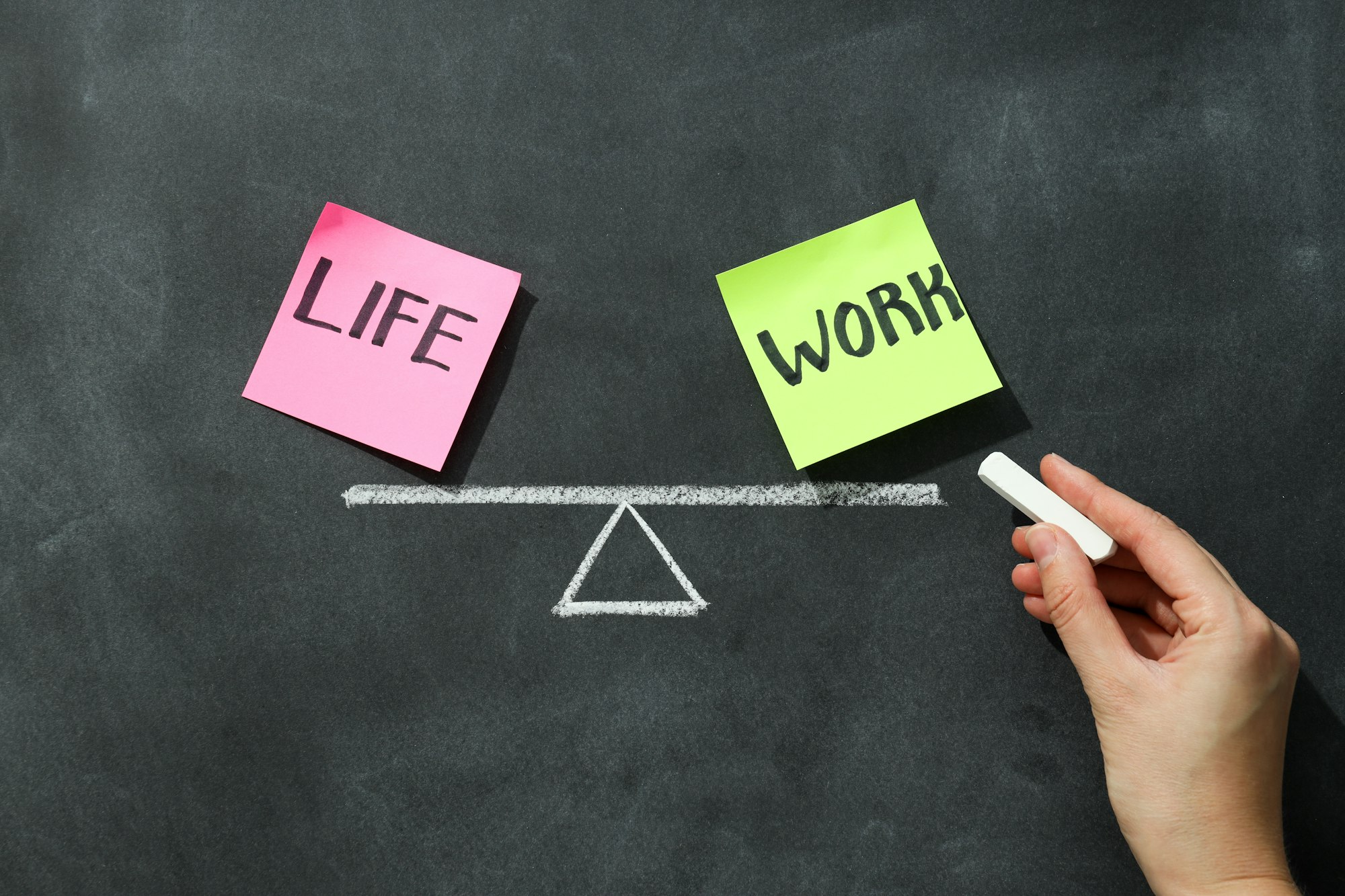
Juggling work responsibilities and personal life can feel like a high-wire act. In today’s fast-paced world, achieving a healthy work-life balance isn’t just a luxury; it’s essential for your overall well-being and productivity.
But the big question is, how can you effectively manage your time to strike this balance?
“The key is not to prioritize what’s on your schedule, but to schedule your priorities.” – Stephen Covey
Through practical time management strategies, you can optimize your daily routine to ensure adequate time for both work and personal activities.
Let’s explore how thoughtful planning and prioritization can lead you to a more balanced and fulfilling life.

Time management is more than just a buzzword; it’s a crucial skill for maintaining harmony between your professional and personal lives. When done right, it can lead to increased productivity, reduced stress, and a more fulfilling life. Let’s explore some key strategies to help you achieve that elusive balance.
Set Clear Goals: Start by defining what work-life balance means for you. Setting clear and attainable goals gives you a roadmap to follow, making it easier to allocate your time and resources effectively.
Prioritize Tasks: Not all tasks are created equal. Use methods like the Eisenhower Matrix, which helps you categorize tasks based on their urgency and importance. This ensures that you focus on what truly matters, both at work and at home.
Plan Your Day: A well-structured day starts with a well-thought-out plan. Whether you prefer digital tools or a classic paper planner, outlining your day helps you stay on track and avoid time-wasting activities.
Limit Distractions: Distractions are productivity killers. Identify the main sources of disruption in your daily routine and find ways to limit them. This could mean setting specific work hours, turning off notifications, or designating a quiet workspace at home.
Take Breaks: Regular breaks are essential for maintaining mental clarity and energy throughout the day. Techniques such as the Pomodoro Technique encourage you to work in intervals and take short breaks, enhancing both focus and productivity.
Learn to Say No: Overcommitting can lead to burnout. Be realistic about your time constraints and prioritize commitments that align with your goals. Saying no when necessary is crucial for maintaining balance
Attaining a harmonious work-life balance requires a thoughtful approach to time management. It isn’t just about squeezing more tasks into your day; it’s about prioritizing what’s truly important and making conscious choices on how to allocate your time. Here are some pivotal steps to help you achieve this:
1. Assess Your Current Schedule: Begin by conducting a time audit. Track your activities for a week to identify where your time goes. You’ll be surprised at how small adjustments can free up significant blocks of time.
2. Set Clear Priorities: Distinguish between urgent and important tasks. Use the Eisenhower Matrix to categorize activities into four quadrants, helping you focus on what truly matters. This ensures that high-priority tasks receive your attention first.
3. Create Boundaries: Establish firm boundaries between work and personal life. Define specific work hours and stick to them. Avoid checking work emails during your personal time, and communicate clearly with colleagues about your availability.
4. Use Tools and Technology: Leverage calendars, reminder apps, and project management tools to stay organized. Tools like Trello, Google Calendar, and Asana can streamline your tasks and deadlines, ensuring you manage your time efficiently.
5. Schedule Downtime: It’s crucial to allocate time for relaxation and hobbies. Scheduling downtime can prevent burnout and improve your mental well-being. Treat it as non-negotiable, just like any other important appointment.
By implementing these time management strategies, you can create a balanced and fulfilling lifestyle that accommodates both your professional and personal aspirations. Remember, achieving balance is an ongoing process that requires regular reflection and adjustment.

Creating a comprehensive time management plan is your roadmap to achieving better work-life balance. This plan helps you visualize your daily, weekly, and monthly commitments, ensuring that no task slips through the cracks. But where do you begin?
Start by identifying your most important tasks (MITs). These are the activities that drive your goals forward and have the most significant impact. Once identified, allocate dedicated time blocks each day to focus solely on these MITs. This ensures that you’re making progress on what matters most.
Next, consider conducting a time audit. This involves tracking how you spend your time over a week. Break down your day into 30-minute segments and record each activity.
At the end of the week, review your log to identify patterns and areas where you can optimize your schedule. You may find that you’re spending too much time on unimportant tasks and need to reallocate those hours to more productive activities.
With your MITs and time audit insights in hand, it’s time to build your schedule. Use a combination of time management techniques such as the Pomodoro Technique, time blocking, or the Eisenhower Matrix to structure your day. Each technique serves a distinct purpose, so choose the one that aligns best with your workflow and preferences.
To tie it all together, create a visual representation of your time management plan. Tools like digital calendars, planners, or even simple spreadsheets can be extraordinarily helpful.
Color-coding different categories, such as work, family, and personal time, can help you quickly understand how your day is balanced at a glance.
Remember, a comprehensive time management plan isn’t static. Regularly review and adjust your plan to accommodate changes in your priorities or workload. Flexibility is key to maintaining a sustainable balance between your professional and personal life.
Effective scheduling is more than just penciling in your tasks for the day. For busy professionals, it’s about strategically aligning your tasks with your energy levels and priorities. Let’s dive into some tried-and-true techniques to optimize your schedule.
1. Prioritize Your Tasks: Begin by categorizing your tasks using the Eisenhower Matrix, which divides tasks into four quadrants based on urgency and importance. This helps you focus on high-value activities and ensures you tackle the most critical tasks first.
2. Time Blocking: Dedicate specific blocks of time for different activities. For instance, allocate mornings for creative tasks when your focus is at its peak, and reserve afternoons for meetings and administrative work. This technique minimizes switching between tasks, enhancing productivity.
3. Batch Similar Tasks: Group similar tasks together to maintain a steady workflow. For example, designate specific times of the day for checking emails or returning phone calls. By batching tasks, you reduce the mental load associated with constant task switching.
4. Use the 2-Minute Rule: Adapted from David Allen’s “Getting Things Done” methodology, the 2-Minute Rule advises you to immediately complete any task that takes two minutes or less. This keeps small tasks from piling up and consuming more time in the long run.
5. Schedule Breaks: Incorporate short breaks into your day to maintain high energy levels. Techniques such as the Pomodoro Technique, which advocates for a break after every 25 minutes of focused work, can prevent burnout and increase overall efficiency.
6. Review and Adjust: At the end of each day, review your schedule and assess what worked and what didn’t. Make adjustments as needed to better align with your priorities and enhance productivity.
By implementing these effective scheduling techniques, you can create a more balanced workflow, making it easier to achieve your work-life balance goals.

In today’s digital age, technology offers a treasure trove of tools that can enhance your time management skills. These tools are designed to streamline your workflow, keep you on track, and ensure you make the most of every minute.
Let’s explore some of the most effective technological solutions for managing your time better.
While technology can be a powerful ally in managing your time, it’s essential to use it mindfully. Too many apps and tools can become overwhelming, so choose a few that suit your specific needs and stick with them. Remember, the ultimate goal is to enhance your productivity and achieve a harmonious work-life balance.
Feel like you’re carrying the weight of the world on your shoulders? You’re not alone. Many professionals find themselves overwhelmed by the sheer volume of tasks. Delegate wisely, and you can regain control of your time. The key is understanding what can be delegated and to whom.
Firstly, identify tasks that can be handed off: administrative duties, research, and routine follow-ups. These are prime candidates for delegation. By doing this, you free up time for high-priority tasks that need your direct input.
Using the “Who’s Got the Monkey” method can be a game-changer. This approach ensures that tasks are assigned clearly, with team members aware of their responsibilities.
By categorizing tasks into Boss-imposed time, System-imposed time, and Self-imposed time, you can streamline operations and avoid the pitfalls of multitasking and missed deadlines.
Consider leveraging team members, freelancers, or virtual assistants to take on delegated tasks. This not only lightens your load but also fosters a collaborative environment, empowering everyone involved.
Remember, delegation isn’t just about offloading work—it’s about strategic task distribution. Assign tasks based on team members’ strengths and expertise. This not only ensures efficiency but also enhances the quality of the output.
The benefits of delegation are plentiful. Effective time management, clear task assignments, and problem-solving become second nature. Moreover, you can focus on what truly matters, driving productivity and bolstering your overall job satisfaction.
Ultimately, task delegation is a powerful tool in your time management arsenal. Embrace it, and you’ll not only share the load but also multiply your resources, achieving a balanced and productive professional life.

Taking care of yourself is not just a luxury but a necessity for maintaining productivity. When you prioritize your well-being, you set the foundation for a healthier, more balanced life. So, how can you make self-care a part of your routine?
1. Regular Exercise: Physical activity is a powerful tool for enhancing mental clarity and reducing stress. Whether it’s a short walk during lunch breaks or a yoga session in the morning, integrating exercise into your daily schedule can boost your energy levels and improve your mood.
2. Healthy Eating: Fuel your body with nutritious foods. A diet rich in fruits, vegetables, lean proteins, and whole grains supports sustained energy levels and sharper focus throughout the day. Avoid excessive caffeine and sugar, which can lead to energy crashes.
3. Adequate Sleep: Never underestimate the power of a good night’s sleep. Aim for 7-9 hours per night to enhance cognitive function, improve memory, and increase overall productivity. Create a bedtime routine that signals your body it’s time to wind down.
4. Mindfulness and Meditation: Incorporating mindfulness practices or meditation into your daily routine can significantly reduce stress and anxiety. These practices help you stay present, improve concentration, and foster a sense of calm and balance.
5. Taking Breaks: Do not shy away from taking regular breaks during work. Short breaks can help you recharge, maintaining your productivity throughout the day. Consider techniques like the Pomodoro Technique, which involves working in focused intervals followed by short breaks.
6. Setting Boundaries: It’s crucial to set clear boundaries between work and personal life. Designate specific times for work and ensure they don’t infringe on your personal time. This separation helps prevent burnout and keeps your work-life balance in check.
By incorporating these self-care strategies into your routine, you not only improve your productivity but also enhance your overall quality of life. Remember, taking care of yourself is an ongoing process. It’s about making mindful choices each day that contribute to your well-being and, in turn, your productivity.
Improving your work-life balance starts with effective time management. By clearly defining your priorities and setting realistic goals, you can allocate time more efficiently.
Use techniques such as the Pomodoro Technique or time blocking to segment your day, ensuring you dedicate focus periods for work tasks and personal activities. Incorporating short breaks and limiting distractions can further enhance productivity and reduce stress, giving you more quality time for yourself and your loved ones.
Prioritizing tasks involves distinguishing between what is urgent and what is important. Use tools like the Eisenhower Box to categorize tasks into four quadrants, helping you decide what to tackle first.
Focus on high-impact tasks (those that are both urgent and important) and delegate or defer less critical items. Regularly reassess your priorities to adapt to changing circumstances and avoid burnout.
Scheduling is a cornerstone of effective time management. By creating a structured schedule, you can allocate specific times for work, leisure, and personal commitments.
Utilize digital calendars, like Google Calendar or Microsoft Outlook, to keep track of tasks and set reminders. A well-organized schedule helps prevent over-commitment and ensures you make time for both professional responsibilities and personal activities.
Goal setting provides you with a clear roadmap and direction. By setting SMART goals (Specific, Measurable, Achievable, Relevant, Time-bound), you can break down larger objectives into manageable tasks, making it easier to stay focused and motivated.
Regularly review and adjust your goals to align with your priorities, ensuring that they contribute to a balanced lifestyle. Achieving these goals not only boosts productivity but also provides a sense of accomplishment, contributing to overall well-being.
Integrating mindfulness into your time management practices can significantly enhance your work-life balance. Mindfulness involves being fully present and engaged in the current moment.
Techniques such as mindful meditation and deep-breathing exercises can help reduce stress and increase concentration. By staying mindful, you can make more intentional choices about how you spend your time, reducing the tendency to multitask and improving your ability to focus on what truly matters.
Achieving a true balance between your professional and personal life may seem daunting, but with informed strategies and a commitment to effective time management, it’s entirely possible.
By implementing the tips outlined in this article, you can create a harmonious workflow that leaves ample room for personal fulfillment.
Remember, the key to work-life balance is not just about managing your time better but also about prioritizing tasks, setting realistic goals, and making time for self-care.
It’s about finding a rhythm that allows you to excel at work while also enjoying your personal life to the fullest. Start with small changes, remain consistent, and don’t be afraid to adjust your strategies as you go along.
Take advantage of modern technology to streamline your tasks, lean on your support network, and always make it a point to end your days with a moment of self-reflection. By doing so, you’re not just managing time – you’re enhancing the quality of your life.
So go ahead, apply these techniques, and take control of your time. Your well-being and productivity will thank you!


